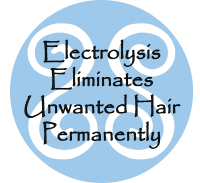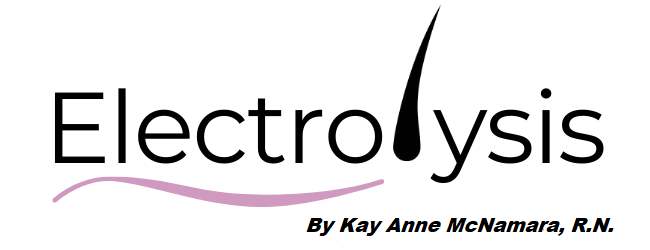Electrolysis F.A.Q.
What is electrolysis?
Electrolysis is the science of permanent hair removal utilizing probe devices. A fine sterile probe is inserted into the hair follicle and a small amount of electrical energy is discharged which destroys the hair growth tissue.
When this is performed by a competent, trained Electrologist, the regenerative ability of the hair follicle is permanently eliminated.
Is electrolysis really the only method of permanent hair removal?
Yes!
Many unethical claims are being made that Laser has been approved as permanent by the FDA. Laser has not been approved for permanance!
According to the FDA, Laser is not not permitted to advertise as permanent or painless (Laser is extremely painful).
What attracts people to laser is it’s supposed speed. Laser, however often requires 5-8 treatments spaced 4-5 weeks apart from each other. This means you’re into the process for 8 months before you even begin Electrolysis. Had these clients been properly educated they could have spent less money, had more comfort and received truely permanent results.
Electrolysis is the only scientifically proven method of permanent hair removal. Temporary methods such as laser, shaving, tweezing, depilatories and waxing require frequent, time consuming maintenance. Skin irritations, ingrown hairs, discoloration, and scarring may result. Some of these methods even contribute to an increase in hair growth activity.
How long does Electrolysis take?
The number of treatments required varies with each client. Those clients that adhere to the recommended treatment schedule usually accomplish their goal between 12 to 18 months.
Some improvement should be observed within six to ten treatments depending upon the quantity and density of the hair, provided the patient adheres to the recommended treatment schedule.
Factors such as hair growth cycles, the quantity and structure of hair, previous use of temporary hair removal methods, heredity, hormone function, normal physiologic changes, certain medications and stress may influence the treatment program.
It is very important to adhere to the recommended treatment program set up by your Electrologist. Those who do so will achieve permanent results in the shortest time frame.
How long does Electrolysis last?
Hair treated properly by Electrolysis will never grow back. Hormonal issues later in life may cause new hair to grow, especially for women around the lip and chin. These are new follicles that did not produce hair in the past and therefore could not have been treated. Remember that only hair that has broken through the skin can be permanently treated.
Is Electrolysis painful?
Most of my clients comment that Electrolysis was not as bad as they had heard. The best way I can describe the sensation, is to compare it to a slight stinging sensation. This is not a comfortable sensation but most would agree that it is hardly unbearable.
Having said that, it is impossible to destroy hair growth tissue without sensation because each hair follicle is surrounded by its own network of nerve endings. The sensation, which may be felt, is assurance that destructive activity is taking place. Even though some parts of the body are more sensitive than others, adjustments can be made which may help to make the treatment more comfortable.
Compared to laser, Electrolysis is a walk in the park. Many equate the feeling of laser to the snapping of a hard rubber band against the skin. They often fail to mention that the snapping is continuous for several seconds for each application. Don’t be fooled when they tell you their laser is equipped with a special “cooling plate”. The pain described above is after the use of the “cooling plate”. Each application treats a service approximately 1 1/2 square inches at a time so several applications are needed to treat a large area. This may not be so bad if it actually worked. Often patients are told they will need additional laser treatments and then will need to finish with Electrolysis.
How do I choose a good Electrologist?
If you are considering undergoing electrolysis, it is very important that you do your research before committing to an appointment. The wrong decision can mean extra sessions and cost and unnecessary discomfort. By following the guidelines listed below, you can take comfort in knowing that you will be making an educated and informed decision when choosing an electrologist.
Know their qualifications. Many states require that electrologists be licensed or certified within the state in order to practice electrolysis. If you live in those states, be sure the practitioner’s certificate is current and fully on display. For states that do not regulate electrolysis, look for electrologists who have a certification from an accredited electrology school.
Ask around. One of the best ways to find any good service is to ask friends and family for recommendation. If you know anybody who has undergone electrolysis, ask for his or her input.
Get a consultation. Many places will give you a free consultation. During the consultation, be sure that any and all of your questions about the procedure are answered. Some of the questions you can ask include: how the procedure will feel; an estimate on the number of visits you will likely need; the cost of each visit (this will vary from place to place, and it is best to call around); the length of each session; how long they have been in business; and the number of clients they have treated.
Make sure they use the right technique. Make sure the practitioner uses needle electrolysis, which is the only permanent form of hair removal. Some places may advertise electrolysis, but in reality they use electronic tweezers or photoepilators. These are not permanent hair removal procedures.
Use common sense. When you go to your consultation, look around. Does the place look clean? Do the workers look clean? Do they use disposable gloves or probes? Ask to meet to person who will be performing the electrolysis for you. Does he or she strike you as professional? If you are not personally comfortable with somebody, do not go to him or her. Personal comfort is essential to knowing you have made the right decision in choosing an electrologist.
Do Electrologists follow appropriate Infection Control Precautions?
They certainly should!
The American Electrology Association (AEA) with the assistance of the Centers for Disease Control (CDC) developed national Infection Control Standards which include sterilization of all electrology instruments.
If you are currently receiving electrolysis, be sure to verify the operator is using an autoclave since this is the only method of sterilization approved by the department of health. Universal Precautions also dictate strict hand-washing and use of a fresh pair of disposable gloves for each patient.
Does electrolysis damage the skin?
When electrolysis is administered by a competent electrologist using modern equipment and current techniques, there should be no visible skin damage.
Immediately following treatment, there may be a slight redness and/or swelling which usually disappears within a few hours. Occasionally, small whiteheads or tiny scabs may occur. It is important to remember that scabs are a part of the normal healing process and will not cause any permanent damage if they are not picked off.
Can unwanted hair be removed from anywhere on the body?
Unwanted hair can be safely removed from most body areas. The most common areas include the hairline, bridge of nose, eyebrows, upper and lower lip, cheeks, sideburns, chin, neck, shoulders, arms and underarms, breasts, abdomen, bikini line, legs back and chest.
The inside of the ears and nose should not be treated.
Can women begin or continue electrolysis treatments during pregnancy?
Although electrology has never been proven harmful to pregnant women, it is suggested that you seek the advice of your physician before beginning treatment.
Who receives electrolysis?
You are not alone if you are embarrassed by unwanted hair. As many as 90% of men and women may be affected by unsightly hair.
Women – Women who are concerned about skin damage and aging are often enthusiastic about electrolysis, since it eliminates the need for tweezing or waxing, processes that can lead to sags over time.
Men – Many men are troubled by unwanted hair. Some common areas of treatment are: eyebrows, especially if a unibrow is of concern; beard sculpting, to eliminate shaving on the cheeks and neck; neckline, to treat skin irritations and ingrown hairs; ears; back and shoulders. Competitive athletes also choose electrolysis for permanent removal of unwanted body hair.
Teens – The adolescent years are among the most exciting and challenging times in a person’s life. A teenager’s future holds a lifetime of changes that profoundly transform both body and mind.
As teens are coming into their own, physical changes such as unsightly hair can negatively impact body image and self-esteem. For teenage girls, it could be the growth of superfluous hair on the side of the face. For teenage boys, it may be the emergence of thick, bulky eyebrows. Some young people feel too embarrassed to speak about their hair concerns, while others go to a parent for advice.
If you’re a teen or the parent of a teen, you can rest assured that there is a permanent solution for removing excess hair safely, comfortably and conveniently – electrolysis.
Can hairs be removed from moles?
Electrolysis can be performed in most moles where licensing regulations allow it. Your electrologist may require written approval from your physician.

